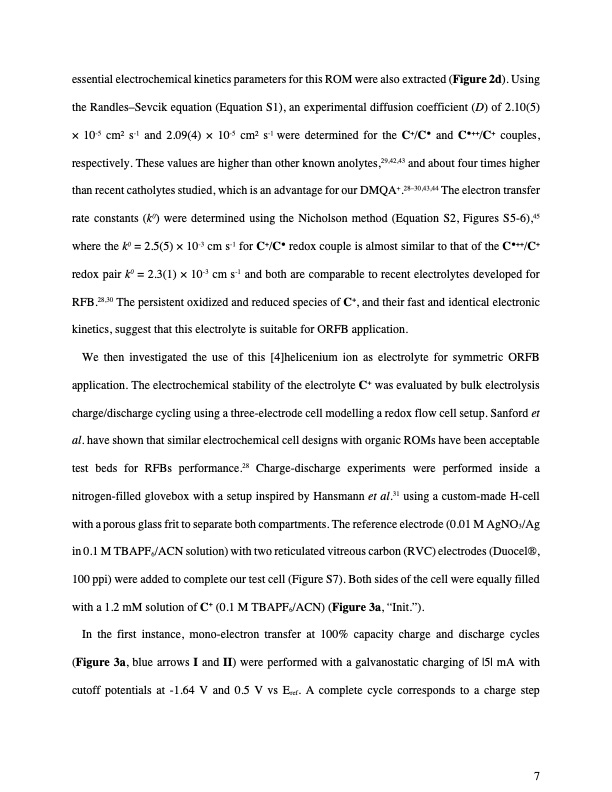
PDF Publication Title:
Text from PDF Page: 007
essential electrochemical kinetics parameters for this ROM were also extracted (Figure 2d). Using the Randles–Sevcik equation (Equation S1), an experimental diffusion coefficient (D) of 2.10(5) × 10-5 cm2 s-1 and 2.09(4) × 10-5 cm2 s-1 were determined for the C+/C● and C●++/C+ couples, respectively. These values are higher than other known anolytes,29,42,43 and about four times higher than recent catholytes studied, which is an advantage for our DMQA+.28–30,43,44 The electron transfer rate constants (k0) were determined using the Nicholson method (Equation S2, Figures S5-6),45 where the k0 = 2.5(5) × 10-3 cm s-1 for C+/C● redox couple is almost similar to that of the C●++/C+ redox pair k0 = 2.3(1) × 10-3 cm s-1 and both are comparable to recent electrolytes developed for RFB.28,30 The persistent oxidized and reduced species of C+, and their fast and identical electronic kinetics, suggest that this electrolyte is suitable for ORFB application. We then investigated the use of this [4]helicenium ion as electrolyte for symmetric ORFB application. The electrochemical stability of the electrolyte C+ was evaluated by bulk electrolysis charge/discharge cycling using a three-electrode cell modelling a redox flow cell setup. Sanford et al. have shown that similar electrochemical cell designs with organic ROMs have been acceptable test beds for RFBs performance.28 Charge-discharge experiments were performed inside a nitrogen-filled glovebox with a setup inspired by Hansmann et al.31 using a custom-made H-cell with a porous glass frit to separate both compartments. The reference electrode (0.01 M AgNO3/Ag in 0.1 M TBAPF6/ACN solution) with two reticulated vitreous carbon (RVC) electrodes (Duocel®, 100 ppi) were added to complete our test cell (Figure S7). Both sides of the cell were equally filled with a 1.2 mM solution of C+ (0.1 M TBAPF6/ACN) (Figure 3a, “Init.”). In the first instance, mono-electron transfer at 100% capacity charge and discharge cycles (Figure 3a, blue arrows I and II) were performed with a galvanostatic charging of |5| mA with cutoff potentials at -1.64 V and 0.5 V vs Eref. A complete cycle corresponds to a charge step 7PDF Image | Organic Redox Flow Battery Helical Carbeniun Ion

PDF Search Title:
Organic Redox Flow Battery Helical Carbeniun IonOriginal File Name Searched:
high-voltage-organic-redox-flow-battery-helical-carbenium-ion-electrolyte.pdfDIY PDF Search: Google It | Yahoo | Bing
Salgenx Redox Flow Battery Technology: Salt water flow battery technology with low cost and great energy density that can be used for power storage and thermal storage. Let us de-risk your production using our license. Our aqueous flow battery is less cost than Tesla Megapack and available faster. Redox flow battery. No membrane needed like with Vanadium, or Bromine. Salgenx flow battery
| CONTACT TEL: 608-238-6001 Email: greg@salgenx.com | RSS | AMP |